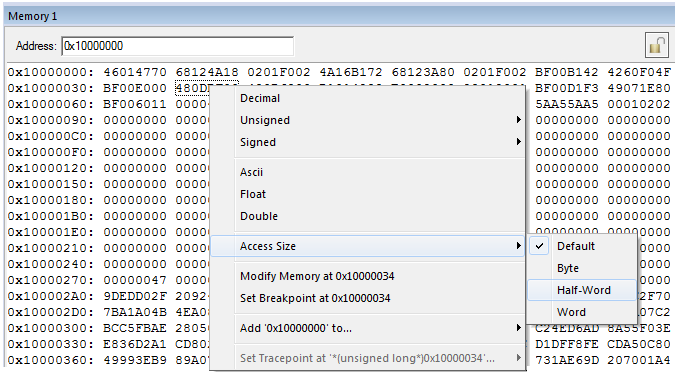|
||
| Products Download Events Support Videos | ||
Technical Support
On-Line Manuals
µVision User's Guide


 Memory Window
Memory Window
The Memory window displays the memory area content. Several memory windows can be used at a time.
![]() Open the windows from the toolbar or using
the menu View - Memory Windows.
Open the windows from the toolbar or using
the menu View - Memory Windows.

Where
| Address | Enter an expression that evaluates to a memory address. |
| result pane |
Shows the memory address and the memory content. Double-click a
value to change the content. The font color indicates the
memory use (available in Simulation mode for Cortex-Mx, ARM9,
and ARM7 processor-based devices):
The content is updated:
|
| Lock buttons freeze/unfreeze the window content temporarily. |
Context Menu
The context menu allows you to:
- Select the output format.
- Modify the memory value.
- Set breakpoints.
- Add the Address to another debug window.
- Set Tracepoints.
The context menu Access Size sets the bus access size for memory accesses. The access size is selectable for each separate memory window. If this feature is not supported by the target driver or the target hardware, then the extra context menu entry is not displayed. In this case, accesses are performed with the Default settings. Access Size values can be:
- Default: The target driver decides which access size to use. Can be a mixture of 32-/16-/8-bit accesses; the actually used access size is, for example, influenced by the alignment and the number of bytes to access.
- Byte: Only 8-bit accesses are used.
- Half-Word: Only 16-bit accesses are used.
- Word: Only 32-bit accesses are used.
Unaligned accesses will be extended to aligned accesses if having selected one of "Byte", "Half-Word", and "Word". Unaligned write accesses can result in read-modify-write accesses to the concerned memory.
ProductsDevelopment Tools |
Hardware & Collateral |
Downloads |
Support |
Contact |
